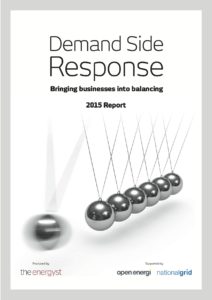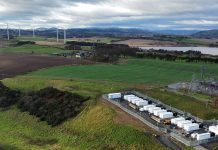
National Grid must simplify demand side response programmes if it is to meet its ambitious targets, according to business leaders.
The system operator has set out plans to derive up to half of system balancing by 2020 by asking UK businesses to respond to signals rather than telling power stations to adjust output.
Appetite for disruption?
The vast majority (79%) of businesses surveyed by The Energyst stated that they would be interested in providing demand response services if it did not disrupt their operations. Most of them could shift up to 10% of their loads upon request. Almost a third (29%) believe up to 25% of their energy usage could be made flexible. That statistic suggests National Grid can meet its target.
Welcome to the jungle
However, confusion about how existing demand response programmes operate and interact is stifling the current market, according to aggregators.
Current demand response mechanisms include Fast Frequency Response, Bridging Frequency Response, Short Term Operating Reserve (STOR), STOR Runway, Demand Side Balancing Reserve and the Capacity Market. Separately, the department of energy and climate change (Decc) is running the Electricity Demand Reduction Pilot Scheme. Programmes such as Triad also incentivise major energy users to power down during winter peaks.
“There are an awful lot of schemes out there,” Chris Kimmett, commercial manager at aggregator Open Energi told The Energyst. “The language used around them is not easy to understand. There is no clear guidance to say: this is exactly what National Grid buys; this is why; this is the price it is willing to pay; and here are the assets that are suitable for these markets.
“Very little central guidance comes out from National Grid on that. But I think [creating better guidance for businesses] would deliver a quick win.”
It’s so easy
That might drive participation in existing programmes but does not address the underlying problem, according to Tim Rotheray, head of the Association for Decentralised Energy, with which the UK Demand Response Association recently merged. He thinks simplifying the market rather than rewriting the instruction manual might be a better approach.
“There is a need for education, but that is possibly the wrong way to go about things,” says Rotheray.
“Instead of explaining a complex raft of mechanisms, flip it on its head. Let’s understand what the market can provide and then design the simplest, most effective way for those services to be brought forward in a cost-effective manner.”
“The work by National Grid, Ofgem and Decc must come together,” Rotheray continues. “That is definitely not the way policy is presented to the user at the moment. They face a barrage of options.”
Live and let die
Streamlining and simplifying policies may also head off problems further down the track. Utilitywise head of markets Jon Ferris suggests that if National Grid’s attempts to rapidly scale the demand side response market pay off, it could create conflict at precisely the time when the capacity market kicks in.
“The question I have is, if that happens in 2018/19, how much does the capacity market coming in dampen the volatility in short term prices?” said Ferris. “There are multiple schemes that conflict with each other and it is hard to see which ones are going to win out at the moment.”
Patience
National Grid acknowledges the challenge it has set itself, and is looking to industry to help solve some of those type of problems.
“We don’t have all the answers,” said National Grid head of commercial operations Duncan Burt. “We understand that there are plenty of different industry agendas and interests to navigate.”
Demand side response, said Burt challenges many existing business models. “On the other hand, it creates opportunities for new ones. My hope is that Power Responsive [Grid’s dedicated platform to scale DSR] will engage a wider range of industries… and open up the borders of the market beyond early adopters.”
Get in the ring
Burt urged businesses to help shape the future of demand side response by telling Grid how programmes might better work around their processes.
“We need to approach the future of DSR with an open mind. Which is why we’re actively seeking out different thoughts and ideas through our Power Responsive campaign. And we need everyone else to be equally open-minded to maximise the benefits to all,” he said.
“We don’t have all the answers. What we do know is that the technology is primed, there’s momentum behind the effort and working together we can shape and share the possibilities created by demand side solutions.”
To download a free report on scaling demand side response, and to attend a breakfast briefing on DSR with National Grid and Open Energi hosted by The Energyst, click here.
Related articles:
National Grid launches major demand-side response push
Demand response: Suppliers and aggregators ignoring 80% of UK firms
National Grid moots demand response rule changes as supply margins tighten
National Grid delighted with demand response but warns over winter tightness
Lord Redesdale ‘puts money on brownouts or blackouts by year end’
Utilitywise bets against Lord Redesdale on blackouts risk
Supply not demand: Capacity market design risks higher decarbonisation bill
National Grid urges major energy users to provide demand response for winter peak, may pay more
Decc remains ‘confident’ of beating Tempus Energy’s demand-side legal challenge
Decc tenders work to scope demand side response in future electricity capacity auctions
UK firms with CHP plant could be paid to stop exporting power
CFD appeals may cost unsuccessful generators, Decc warns
Energy minister dismisses big company bias claims in CFD and capacity auctions
Another fine mess: Energy policy’s perverse outcomes mean ‘new Energy Act in 2017‘
Click here to see if you qualify for a free subscription to the print magazine, or to renew.
Follow us at @EnergystMedia. For regular bulletins, sign up for the free newsletter.




[…] new survey assessing how the UK can unlock the full potential of demand side response (DSR) found that the […]